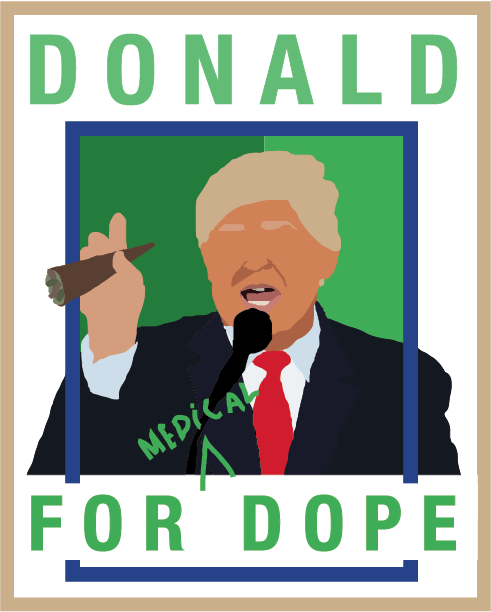Donald for Dope
Medicinal marijuana should be legalized in all states under Trump administration
Unlike the majority of his party, President-elect Donald Trump, along with select members from his growing cabinet, have openly supported the legalization of medical marijuana in America.
And there is nothing bad about that.
Marijuana has been used for many years as a medical staple, and it would continue to help countless lives if legalized, while hurting very few.
No law should be able to take this practical resource away from Americans.
The first recorded use of marijuana as a medicine was in 2900 B.C. in China.
Since then, the drug has been used for a variety of practices throughout the world.
By 1850, it reached popularity in the United States. It quickly began to appear in most medicines, including those to alleviate asthma, cholera and leprosy.
However, the hype of the newfound medical miracle died with the introduction of the Marihuana Tax Act of 1937, which made marijuana illegal to sell, use or possess in the U.S.
By 1970, the act was replaced by the Controlled Substance Act, which classified substances by level of risk and addiction. It placed marijuana in the most dangerous division, despite the drug’s typically nonaddicitive nature and, at the time, unresearched dangers.
Although the decision has seen questioning and scrutiny over the decades, nationally it has yet to move into a lower category, which would make the drug legal for medicinal purposes throughout the U.S. once again.
On a state-level, 26 states have already legalized medical marijuana.
According to WebMD.com, the body produces chemicals similar to marijuana to help alleviate pain naturally. Using marijuana would aid this process for patients, such as war veterans, experiencing serious levels of discomfort.
Additionally, marijuana can be used to treat seizures, Crohn’s disease, glaucoma, multiple sclerosis, alcoholism, anorexia, arthritis, sleep apnea, shingles, cystic fibrosis, PTSD, autoimmune disease, AIDS and chemotherapy side effects such as nausea and poor appetite.
For most patients who experience these diseases and symptoms on a day-to-day basis, marijuana is the best, and sometimes only, option for relief.
Marijuana is also harder to overdose or become addicted from using it compared to most pain relieving drugs.
In a study conducted between 1999 and 2010, it was found that death rates for painkiller overdoses were an average of 25 percent lower in states that legalized medical marijuana compared to those that didn’t.
Marijuana has fewer and shorter-lasting side effects than many legal drugs. The list of potential side effects is relatively short — dizziness, drowsiness, short-term memory loss, euphoria and anxiety.
For opioids, a legal drug, used for reasons similar to those of marijuana, the list is a little more serious. Just a few of the side effects linked with opioids are constipation, nausea, drowsiness, vomiting, anxiety, irritability and muscle pain.
Opioids are involved in 61 percent of all drug overdose deaths.
Marijuana’s few side effects are insignificant in comparison, especially considering in order to overdose the drug, over 40,000 times the dose would be required in intake.
Marijuana is a useful and practical drug which is evident in its wide use world-wide.
Before extensive research was able to be conducted, for centuries people were aware of its medical benefits in their everyday lives. Now that research has been done to prove these pain relieving properties and discover the few cons of using the drug, there is no reason it should be illegal in any of the 50 states.
This is no-doubt a feasible improvement the Trump administration could make for Americans.
If 26 states have already determined the drug suitable for their residents after carefully examining its advantages and disadvantages, the other 24 should be able to take the same step forward.

Alli Williams is a co-editor in chief for “The Tiger Print.” She works as an assistant teacher at a math tutoring business. Her favorite part of journalism...




